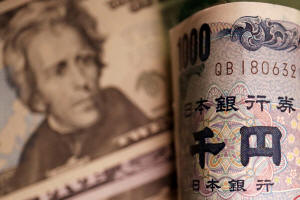Analysis-G7 fails to reach intervention deal to ease pain of soaring
dollar
 Send a link to a friend
Send a link to a friend
 [October 17, 2022] By
Leika Kihara [October 17, 2022] By
Leika Kihara
WASHINGTON (Reuters) - Japan and other
countries facing the fallout from a soaring U.S. dollar found little
comfort from last week's meetings of global finance officials, with no
sign that joint intervention along the lines of the 1985 "Plaza Accord"
was on the horizon.
With a strong push from Japan, finance leaders of the Group of Seven
advanced economies included a phrase in a statement on Wednesday saying
they will closely monitor "recent volatility" in markets.
But the warning, as well as Japanese Finance Minister Shunichi Suzuki's
threat of another yen-buying intervention, failed to prevent the
currency from sliding to fresh 32-year lows against the dollar as the
week came to a close.
While Suzuki may have found allies grumbling over the fallout from the
U.S. central bank's aggressive interest rate hike path, he conceded that
no plan for a coordinated intervention was in the works.

"Many countries saw the need for vigilance to the spill-over effect of
global monetary tightening, and mentioned currency moves in that
context. But there wasn't any discussion on what coordinated steps could
be taken," Suzuki said in a news conference on Thursday after attending
separate meetings of the G7 and G20 finance leaders in Washington.
U.S. Treasury Secretary Janet Yellen made clear that Washington had no
appetite for concerted action, saying the dollar's overall strength was
a "natural result of different paces of monetary tightening in the
United States and other countries."
"I've said on many occasions that I think a market-determined value for
the dollar is in America's interest. And I continue to feel that way,"
she said on Tuesday, when asked if she would consider a Plaza Accord 2.0
agreement.
NO YEN SUPPORT
In 1985, a destabilizing surge in the dollar prompted five countries -
France, Japan, the United Kingdom, the United States and what was then
West Germany - to band together to weaken the U.S. currency and help
reduce the U.S. trade deficit. Following the deal, named the Plaza
Accord for the famed New York hotel where it was hammered out, the
dollar shed roughly 25% of its value over the ensuing 12 months.
With no current U.S. interest in engineering that kind of deal, other
countries have to find ways to mitigate the pain stemming from a strong
dollar, which has forced some emerging economies to hike interest rates
to defend their currencies even at the cost of cooling economic growth
more than they want.
Emerging Asian nations have seen significant capital outflows this year
that are comparable to previous stress episodes, heightening the need
for policymakers to build liquidity buffers and take other steps to
prepare for turbulence, said Sanjaya Panth, deputy director for the
International Monetary Fund's Asia and Pacific Department.

"The situation for Asian economies is very different from where they
were 20 years ago" as countries accumulated foreign reserves that make
them more resilient to external shocks, Panth told Reuters on Thursday
on the sidelines of the IMF and World Bank annual meetings in
Washington.
[to top of second column] |

Banknotes of Japanese yen and U.S.
dollar are seen in this illustration picture taken September 23,
2022. REUTERS/Florence Lo/Illustration

"At the same time, the rising debt levels, particularly in some
economies in the regions, are a concern," he said. "Some form of
market stress cannot be ruled out."
The Bank of Korea delivered its second-ever 50-basis-point interest
rate hike on Wednesday and made clear the won's 6.5% slide against
the dollar in September that drove up import costs played a key role
in the decision.
South Korea's central bank Governor Rhee Chang-yong said on Saturday
he does not sense an interest among U.S. officials to stem the
dollar's strength through joint intervention.
But he said some kind of international cooperation on the dollar may
be needed "after a certain period."
"I think a too-strong dollar, especially for a substantial period,
won't be good for the Unites States either, and actually I'm
thinking about the long-term implication for the trade deficit, and
maybe another global imbalance may happen," he said.
In Japan, the onus is on the government to deal with a renewed
plunge in the yen, caused in part by the policy divergence between
the Federal Reserve's determination to raise U.S. interest rates and
the Bank of Japan's resolve to keep borrowing costs ultra-low.
At the news conference where Suzuki issued his warning about sharp
yen falls, BOJ Governor Haruhiko Kuroda ruled out anew the chance of
a rate hike.
The dollar jumped about 1% to a fresh 32-year high of 148.86 yen on
Friday, testing authorities' resolve to combat the Japanese
currency's relentless slide. The dollar/yen is now up roughly 2%
from levels when Japan intervened on Sept. 22 to buy yen for the
first time since 1998.
Japanese policymakers have said they won't seek to defend a certain
yen level, and instead will focus on smoothing volatility.

Masato Kanda, the country's top currency diplomat, told reporters on
Friday that authorities were ready to take "decisive action any
time" if excessively volatile yen moves continued.
Even moderating abrupt yen moves, however, could be a challenge as
Kuroda's assurance that the BOJ will keep interest rates in negative
territory gives investors a green light to continue dumping the
currency.
"It's impossible to reverse the yen's downtrend with solo
intervention," said Daisaku Ueno, chief forex strategist at
Mitsubishi UFJ Morgan Stanley Securities.
"Once the yen falls below 150 to the dollar, it's hard to predict
where its depreciation could stop because there's no technical chart
support until around 160," he said.
(Reporting by Leika Kihara; Additional reporting by Daniel Burns in
Washington and Tetsushi Kajimoto in Tokyo; Editing by Paul Simao)
[© 2022 Thomson Reuters. All rights
reserved.]
This material may not be published,
broadcast, rewritten or redistributed.
Thompson Reuters is solely responsible for this content. |